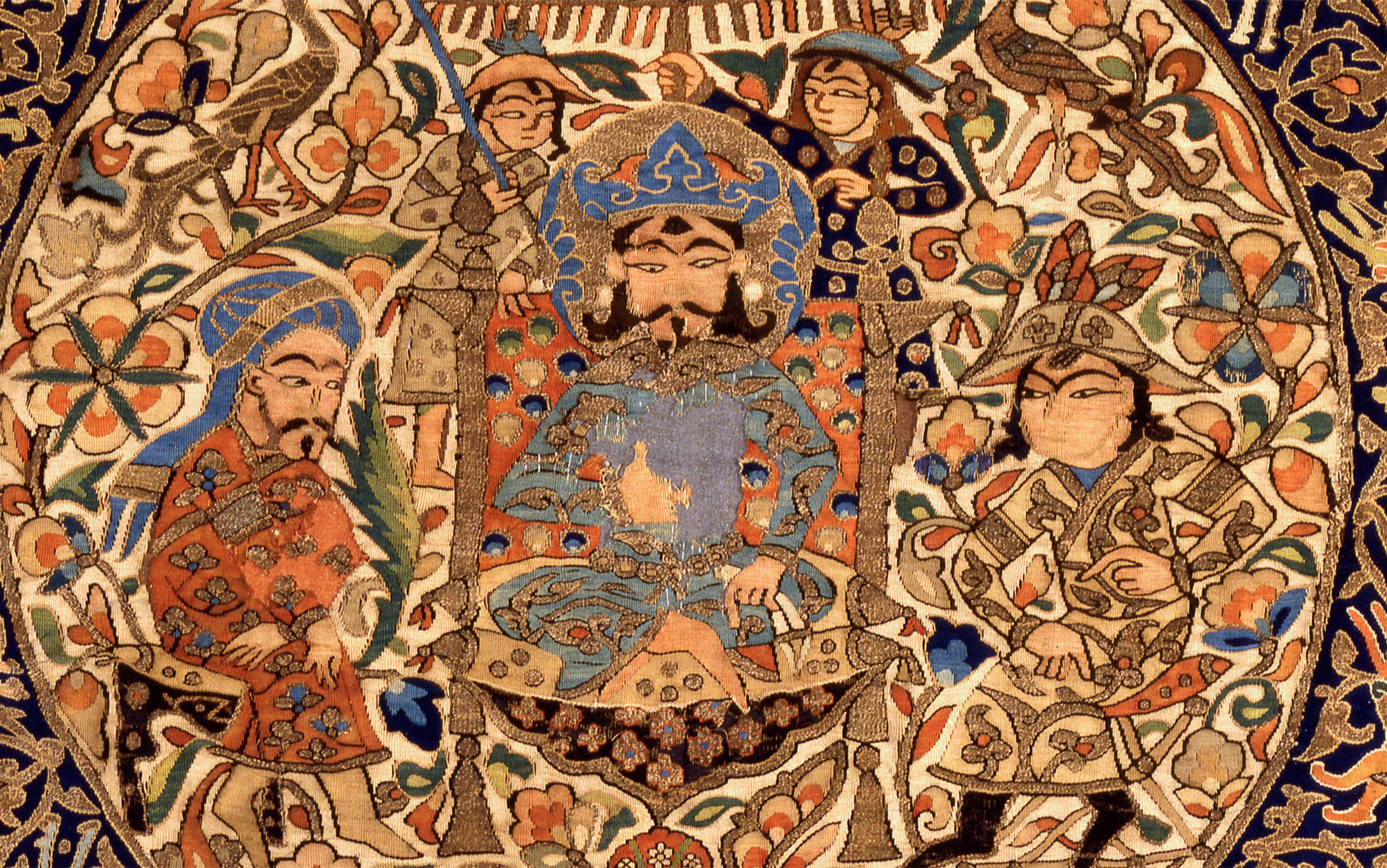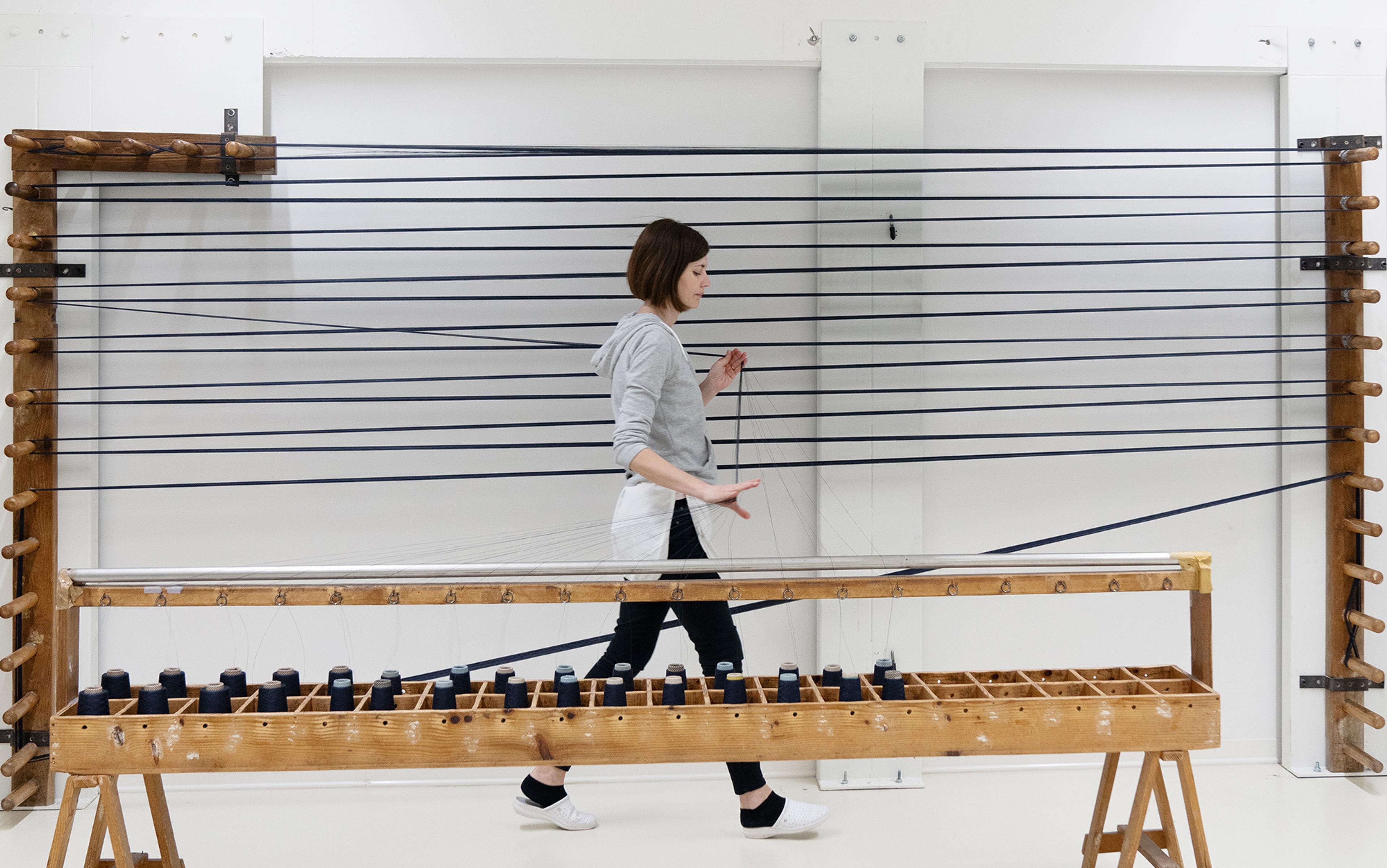In February 1939, Vogue ran a major feature on the fashions of the future. Inspired by the soon-to-open New York World’s Fair, the magazine asked nine industrial designers to imagine what the people of ‘a far Tomorrow’ might wear and why. (The editors deemed fashion designers too of-the-moment for such speculations.) A mock‑up of each outfit was manufactured and photographed for a lavish nine-page colour spread.
You might have seen some of the results online: an evening dress with a see-through net top and strategically placed swirls of gold braid, for instance, or a baggy men’s jumpsuit with a utility belt and halo antenna. Bloggers periodically rediscover a British newsreel of models demonstrating the outfits while a campy narrator (‘Oh, swish!’) makes laboured jokes. The silly get‑ups are always good for self-satisfied smirks. What dopes those old-time prognosticators were!
The ridicule is unfair. Anticipating climate-controlled interiors, greater nudity, more athleticism, more travel and simpler wardrobes, the designers actually got a lot of trends right. Besides, the mock‑ups don’t reveal what really made the predicted fashions futuristic. Looking only at the pictures, you can’t detect the most prominent technological theme.
‘The important improvements and innovations in clothes for the World of Tomorrow will be in the fabrics themselves,’ declared Raymond Loewy, one of the Vogue contributors. His fellow visionaries agreed. Every single one talked about textile advances. Many of their designs specified yet-to-be-invented materials that could adjust to temperature, change colour or be crushed into suitcases without wrinkling. Without exception, everyone foretelling the ‘World of Tomorrow’ believed that an exciting future meant innovative new fabrics.
They all understood something we’ve largely forgotten: that textiles are technology, more ancient than bronze and as contemporary as nanowires. We hairless apes co-evolved with our apparel. But, to reverse Arthur C Clarke’s adage, any sufficiently familiar technology is indistinguishable from nature. It seems intuitive, obvious – so woven into the fabric of our lives that we take it for granted.
We drag out heirloom metaphors – ‘on tenterhooks’, ‘tow-headed’, ‘frazzled’ – with no idea that we’re talking about fabric and fibres. We repeat threadbare clichés: ‘whole cloth’, ‘hanging by a thread’, ‘dyed in the wool’. We catch airline shuttles, weave through traffic, follow comment threads. We talk of lifespans and spin‑offs and never wonder why drawing out fibres and twirling them into thread looms so large in our language.
The story of technology is in fact the story of textiles. From the most ancient times to the present, so too is the story of economic development and global trade. The origins of chemistry lie in the colouring and finishing of cloth. The textile business funded the Italian Renaissance and the Mughal Empire; it left us double-entry bookkeeping and letters of credit, Michelangelo’s David and the Taj Mahal. As much as spices or gold, the quest for fabrics and dyestuffs drew sailors across strange seas. In ways both subtle and obvious, textiles made our world.
Most conspicuously, the Industrial Revolution started with the spinning jenny, the water frame, and the thread-producing mills in northern England that installed them. Before railroads or automobiles or steel mills, fortunes were made in textile technology. The new mills altered where people lived and how they worked. And the inexpensive fabrics they produced changed the way ordinary people looked.
Then, a second conspicuous wave of textile innovation began with the purple shade that francophile marketers named mauve. The invention of aniline dyes in the mid-19th century made a full spectrum of colour – including newly intense blacks – universally available. The synthetic-dye business gave rise to the modern chemical industry, and yet more technology-based fortunes.
The visionaries of 1939 knew this industrial history. They knew, too, that a third round of textile breakthroughs had begun. Cellulose-based synthetics such as rayon were already common, and just months earlier, DuPont had patented its first polymer and heralded the nylon stockings to come. Like the dyes before them, 20th-century fibres would not be wrested from living nature but designed in labs. Once again, fortunes would be made and, once again, the textures of daily life would change.
As late as the 1970s, textiles still enjoyed the aura of science. Since then, however, we’ve stopped thinking of them as a technical achievement. In today’s popular imagination, fabric entirely belongs to the frivolous world of fashion. Even in the pages of Vogue, ‘wearable technology’ means electronic gadgets awkwardly tricked out as accessories, not the soft stuff you wear against your skin – no matter how much brainpower went into producing it. When we imagine economic progress, we no longer think about cloth, or even the machines that make it.
This cultural amnesia has multiple causes. The rise of computers and software as the very definition of ‘high technology’ eclipsed other industries. Intense global competition drove down prices of fibres and fabric, making textiles and apparel a less noticeable part of household budgets, and turning textile makers into unglamorous, commodity businesses. Environmental campaigns made synthetic a synonym for toxic. And for the first time in human history, generations of women across the developed world grew up without learning the needle arts.
As understandable as it might be, forgetting about textiles sacrifices an important part of our cultural heritage. It cuts us off from essential aspects of the human past, including the lives and work of women. It deprives us of valuable analogies for understanding how technology and trade transform economies and culture. It blinds us to some of today’s most pervasive innovations – and some of tomorrow’s most intriguing.
The ancient Greeks worshiped Athena as the goddess of technē, the artifice of civilisation. She was the giver and protector of olive trees, of ships and of weaving (without which there would be no sails). When she and Odysseus scheme, they ‘weave a plan’. To weave is to devise, to invent – to contrive function and beauty from the simplest of elements. Fabric and fabricate share a common Latin root, fabrica: ‘something skillfully produced’. Text and textile are similarly related, from the verb texere, to weave. Cloth-making is a creative act, analogous to other creative acts. To spin tales (or yarns) is to exercise imagination. Even more than weaving, spinning mounds of tiny fibres into usable threads turns nothing into something, chaos into order.
‘The spindle was the first wheel,’ explains Elizabeth Barber, professor emerita of linguistics and archeology at Occidental College in Los Angeles, gesturing to demonstrate. ‘It wasn’t yet load-bearing, but the principle of rotation is there.’ In the 1970s, Barber started noticing footnotes about textiles scattered through the archaeological literature. She thought she’d spend nine months pulling together what was known. Her little project became a decades-long exploration that turned textile archaeology into a full-blown field. Textile production, Barber writes in Prehistoric Textiles (1991), ‘is older than pottery or metallurgy and perhaps even than agriculture and stock-breeding’.
Of course, pottery and metal artifacts survived the centuries much better than cloth, which is rarely found in more than tiny fragments. That’s one reason we tend to forget how important textiles were in the earliest economic production. We envision an ancient world of hard surfaces much as we imagine the First World War in black and white.
Tech entrepreneur David Orban proposed that his fellow Bitcoin evangelists adopt ‘weaving’ rather than ‘mining’ as their metaphor for their work
But before there was gold or silver currency, traders used cloth. In the 20th century BC, the Minoan kingdom on resource-poor Crete swapped wool and linen for the metals that its famed craftsmen, represented by the mythical Daedalus, used to create their wares. In the pre-monetary trade of the ancient Aegean and Anatolia, writes the archaeologist Brendan Burke in From Minos to Midas (2010), textile production was of ‘greater value and importance … than the production of painted clay pots, metal tools, and objects carved from precious metals: everyone depended on cloth’.
Archaeologists often track fabric production by what is left behind. Huge numbers of spindle whorls (usually of clay) survive, as do the clay loom weights that held vertically hung warp threads in tension. By counting the clay weights left from his workshops’ looms, writes Barber, ‘we can calculate that King Midas of Gordion could have kept over 100 women busy weaving for him, which makes him more than twice as rich as Homer’s fabulous King Alkinnoos [Alcinous, from the Odyssey], who had 50. No wonder the Greeks viewed Midas as synonymous with gold!’
No wonder, too, that the first modern articulation of the idea of ‘division of labour’ wasn’t Adam Smith’s example of a 1770s pin factory but a 1690 explanation by the English economist William Petty that ‘Cloth must be cheaper made, when one Cards, another Spins, another Weaves, another Draws, another Dresses, another Presses and Packs.’ By then, the division of labour in textile production – and the trade with far-flung markets that made it profitable – was already 3,000 years old.
Last spring, the tech entrepreneur David Orban proposed that his fellow Bitcoin evangelists adopt ‘weaving’ rather than ‘mining’ as their metaphor for the work of encoding and recording the public ledger of Bitcoin transactions. ‘Weavers,’ he wrote, ‘take the intertwined threads and through their expert, value-added activity create a strong fabric – which is exactly what the global distributed network of computers creating the Bitcoin Blockchain does!’
To give his argument geek cred, Orban cited the historical titbit every new programming student learns: before punchcards were applied to computers, they were used to control the patterns on jacquard looms.
The connection actually goes deeper. Weaving is the original binary system, at least 9,000 years old. Warp threads are held in tension, and weft threads go over or under them. Over-under, up-down, on-off, one-zero. Punch cards could control looms because weaving is intrinsically binary. By the time Joseph Marie Jacquard’s card-driven machine came around in 1801, human weavers had been imagining and recording complex either-or patterns for thousands of years.
Orban also reminded Bitcoin fans that the original 19th-century Luddites had attacked mechanical looms. Here, too, the more you know about textile history, the more complex and interesting the analogy becomes. The creative destruction that made colourful clothes plentiful came in waves and, before weavers were its victims, they were its beneficiaries. The Industrial Revolution started not with weaving but with spinning.
Whether they were captives in ancient Crete, orphans in the Florentine Ospedale degli Innocenti, widows in South India or country wives in Georgian England, women through the centuries spent their lives spinning, especially after water wheels freed up time previously devoted to grinding grain. Turning fibre into thread was a time-consuming, highly skilled craft, requiring dexterity and care. Even after the spread of the spinning wheel in the Middle Ages, the finest, most consistent yarn, as well as strong warp threads in general, still came from the most ancient of techniques: drop spinning, using a hooked or notched stick with a weight as a flywheel.
With labour short and wages high, the eve of the Industrial Revolution was a great time to be a spinster
Spinning was the major bottleneck in making cloth. In the late 18th century, the thriving worsted industry in Norwich in the east of England employed 12,000 looms but 10 times as many spinners producing fine wool thread. The demand for spinning was so high, estimates the economic historian Craig Muldrew, that it employed more than a million married women in an English workforce of 4 million, providing about a third of the income of poorer families.
A spinster is a woman who spins. Unmarried women with no children and few domestic chores could work longer hours without distraction, earning as much as male day-labourers and, Muldrew suggests, possibly delaying or even avoiding marriage. Spinning also gave poor girls a more lucrative option than domestic service, leading to complaints of a servant shortage. With labour short and wages high, the eve of the Industrial Revolution was a great time to be a spinster.
But a bottleneck is a problem waiting to be solved, and inventors started looking for ways to get more thread with less labour. Like self-driving cars or cheap, clean energy today, spinning machines seemed obviously desirable. In 1760, Britain’s Society for the Encouragement of Arts, Manufactures and Commerce offered prizes for ‘a Machine that will spin Six Threads of Wool, Flax, Cotton, or Silk at one time, and that will require but one Person to work it’.
Nobody won, but within a few years the northern English carpenter James Hargreaves introduced the spinning jenny. It was, writes the economic historian Beverly Lemire in Cotton (2011), ‘the first robust machine that could consistently produce multiple spindles of thread from the effort of a single spinster’. Soon after, his fellow Lancastrian inventor Richard Arkwright refined mechanical spinning with water-powered innovations that improved thread quality and integrated carding and roving (twisting fibres to prepare them for spinning) into a single process. Arkwright’s mills decisively moved thread production from the cottage to the factory.
It was suddenly a bad time to be a spinster, or a family whose household income depended in part on spinning.
A generation before the Luddite movement, these ‘patent machines’ sparked an anti-technology backlash. Protesters smashed machinery and demanded government relief. Pending parliamentary action, the town of Wigan in England’s north halted the ‘use of all Machines and Engines worked by Water or Horse, for carding, roving, or spinning of Cotton’. A petition to Parliament in 1780 explained that the ‘Evil in Question is the Introduction of Patent Machines and Engines, of various Descriptions, which have superseded Manual Labour to such a fatal and alarming Degree, that … many Thousands … with their Families, [are] pining for want of Employment.’
Parliament commissioned a report but decided against action. Arkwright continued to innovate, adding steam power to his mills. The men who tended his machines, Lemire writes, became ‘the first generation of elite industrial workers. They were well paid and worked with technologies that brought them considerable prestige.’
Nor were they the only winners, at least in the short run. In 1780, Samuel Crompton, another inventor from Lancaster, developed the spinning mule, which for the first time allowed British manufacturers to produce thread as consistently fine and strong as hand-spun Indian cotton. Thread output soared so much that weavers became the new bottleneck. ‘Those within the handloom weaving trade enjoyed a golden heyday,’ writes Lemire, ‘with as much work as they could want and at high rates of pay.’ The golden heyday was not to last. Power looms arrived at the turn of the century.
Vogue’s 1939 panel of visionaries included one contrarian. Like his fellow designers, the American artist George Sakier foresaw great new textile technologies. But he also predicted that the woman of the future would be unimpressed. ‘She will take the miracles of science for granted,’ he said. In the World of Tomorrow, the gee-whiz fabrics imagined in 1939 would be no big deal.
He was mostly right.
More than we realise, we residents of the 21st century simply assume that our clothing will resist wrinkles and stains, that it will stretch as we move, that it will hold its colour and its shape, and feel comfortable against our skin. The incremental innovations that make hoodies breathable or extend the life of upholstery cushions are invisible. They don’t grab public attention the way nylon stockings did. A state-of-the-art raincoat, dress shirt or pair of tights would amaze someone transported from 1939, but nowadays we just expect it to work.
Textiles illustrate a more general point about technology. The more advanced a field is, the more blasé we are about its latest upgrades. Success breeds indifference. We still expect Moore’s Law to hold, but we no longer get excited about the latest microprocessor. The public has largely forgotten the silicon in Silicon Valley.
New and improved fabric technologies haven’t attracted public enthusiasm since the backlash against leisure suits and disco shirts made synthetics declassé in the early 1980s. ‘Pity poor polyester. People pick on it,’ wrote The Wall Street Journal’s Ronald Alsop in 1982, describing DuPont’s efforts to rehabilitate the fibre’s image.
What ended the consumer hatred of polyester wasn’t a marketing campaign. It was a quiet series of technical innovations: the development of microfibres. These are synthetics, most often polyester or nylon, that are thinner than silk and incredibly soft, as well as lightweight, strong, washable and quick-drying. Their shapes can be engineered to control how water vapour and heat pass through the fabric or to create microcapsules to add sunscreen, antimicrobial agents or insect repellent. Over the past decade, microfibres have become ubiquitous; they’re found in everything from wickable workout wear to supersoft plush toys.
Microfibres are one reason the ‘air-conditioned’ fabrics Loewy and his fellow designers foresaw in 1939 have finally come to pass. These fabrics just aren’t promoted in the pages of Vogue or highlighted on the racks at Banana Republic. They don’t attract attention during New York Fashion Week. Their tribe gathers instead at the big Outdoor Retailer trade shows held twice a year in Salt Lake City. There, outdoor-apparel makers and their suppliers tout textiles that keep wearers warm in the cold and cool in the heat; that block raindrops but allow sweat to escape; that repel insects, screen out UV rays and control odour. By establishing that truly weather-resistant fabrics were possible, Gore-Tex (first sold in 1976) and Polartec synthetic fleece (1979) created an industry where engineers now vie to find ever-better ways to conquer the elements. For instance, ‘smart textiles’ originally developed for spacesuits use microencapsulated materials that melt when they get hot, keeping wearers comfortable by absorbing body heat; when temperatures fall, the materials solidify and warm the body.
The fabrics not only trap body heat: given an imperceptible bit of electric charge, they can actually warm the skin
This ingenuity has gradually moved indoors. Start‑ups such as Ministry of Supply and Mizzen and Main are peddling men’s dress clothes made of ‘performance’ materials formerly reserved for sportswear. ‘The apparel that we need to perform the most is the apparel that we wear the most often – the apparel we wear in the office,’ Aman Advani, the co-founder of Ministry of Supply, told Harvard Business School researchers. More significant is the growth of what the garment industry calls ‘athleisure’: think hoodies and yoga pants everywhere.
Looking forward, academic researchers have bigger things in mind. Noting that ‘a large portion of energy continues to be wasted on heating empty space and non‑human objects,’ the materials scientist Yi Cui and his colleagues at Stanford envision replacing central heating systems with ‘personal thermal management’, using breathable fabrics coated in a solution of silver nanowires. The fabrics not only trap body heat: given an imperceptible bit of electric charge, they can actually warm the skin.
Other scientists are looking at ways to make fabric turn body heat or motion into usable energy for low-powered electronics. And some hope to make the temperature-regulating effects of smart textiles work without liquids, whose microencapsulation requires substantial energy use. Shifting the focus from outdoor leisure to indoor life – from fighting the elements to everyday energy use and climate control – dramatically reframes several decades of fabric advances, making textiles part of a larger story about energy and the environment.
Reducing textiles to their functional properties misses much of their appeal, however. They’ve always been decorative as well, a source of sensory pleasure going all the way back to the sexy string skirts worn by Stone Age women. That’s why dyes have been so important in the history of chemistry and trade.
In our computer-centric era, the pursuit of beautiful textiles has naturally turned to information technology. Over the past decade, inkjet printing on fabric has taken off. Instead of requiring a separate plate for each colour, digital printing registers the entire design at once. So for the first time, designers can use as many colours, and as varied patterns, as they choose. Although it currently accounts for less than 5 per cent of printed fabrics, digital printing has already changed the way clothes look. It’s the technology driving the colourful prints so prominent in recent women’s fashion, as well as the crowdsourced design sites Threadless and Spoonflower.
The customers who’ve embraced those designs don’t think much about what makes them possible. But the very invisibility of textiles testifies to their power. We think of them as natural. The instinct behind ‘wearable technology’ is sound, even if the products so far are awkward. ‘Imagine a textile structured from a blend of different fibres which each function as component within a circuit, for example, battery fibres, solar fibres and antenna fibres,’ writes the US fashion technologist Amanda Parkes in an op-ed for the website Business of Fashion. ‘The material itself becomes a self-sustaining “textile circuit” that has its own power and interactive capabilities, but the embedded technology is essentially invisible.’
If the goal is to shrink the distance between nature and artifice, us and it, no technology is as powerful as fabric. Intimate and essential, it touches every moment of our lives. It is among the greatest products of human artifice. Yet it is also an extension of our skin.






